
"Jabberwocky" is a nonsense poem written by Lewis Carroll about the killing of a creature named "the Jabberwock". It was included in his 1871 novel Through the Looking-Glass, the sequel to Alice's Adventures in Wonderland (1865). The book tells of Alice's adventures within the back-to-front world of the Looking-Glass world.
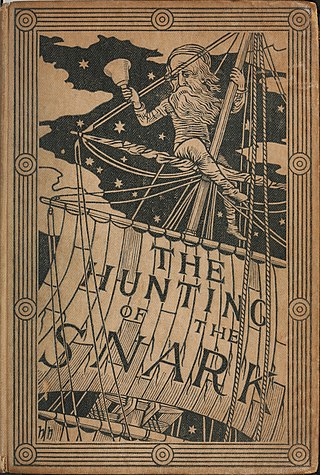
The Hunting of the Snark, subtitled An Agony, in Eight fits, is a poem by the English writer Lewis Carroll. It is typically categorised as a nonsense poem. Written between 1874 and 1876, it borrows the setting, some creatures, and eight portmanteau words from Carroll's earlier poem "Jabberwocky" in his children's novel Through the Looking-Glass (1871).

The Annotated Alice is a 1960 book by Martin Gardner incorporating the text of Lewis Carroll's major tales, Alice's Adventures in Wonderland (1865) and Through the Looking-Glass (1871), as well as the original illustrations by John Tenniel. It has extensive annotations explaining the contemporary references, mathematical concepts, word play, and Victorian traditions featured in the two books.

Alice's Adventures in Wonderland is an 1865 English children's novel by Lewis Carroll, a mathematics don at the University of Oxford. It details the story of a girl named Alice who falls through a rabbit hole into a fantasy world of anthropomorphic creatures. It is seen as an example of the literary nonsense genre. The artist John Tenniel provided 42 wood-engraved illustrations for the book.
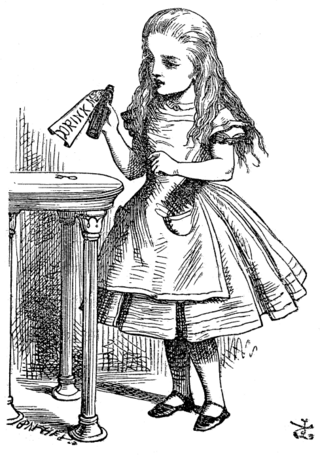
Alice is a fictional character and the main protagonist of Lewis Carroll's children's novel Alice's Adventures in Wonderland (1865) and its sequel, Through the Looking-Glass (1871). A child in the mid-Victorian era, Alice unintentionally goes on an underground adventure after falling down a rabbit hole into Wonderland; in the sequel, she steps through a mirror into an alternative world.

Alice Pleasance Hargreaves was an English woman who, in her childhood, was an acquaintance and photography subject of Lewis Carroll. One of the stories he told her during a boating trip became the classic 1865 children's novel Alice's Adventures in Wonderland. She shared her name with "Alice", the story's protagonist, but scholars disagree about the extent to which the character was based upon her.

Thomas Hood was an English humorist, playwright and author. He was the son of the poet and author Thomas Hood. Pen and Pencil Pictures (1857) was the first of his illustrated books. His most successful novel was Captain Master's Children (1865).

Harry Furniss was a British illustrator. He established his career on the Illustrated London News before moving to Punch. He also illustrated Lewis Carroll's novel Sylvie and Bruno.

Sylvie and Bruno, first published in 1889, and its second volume Sylvie and Bruno Concluded published in 1893, form the last novel by Lewis Carroll published during his lifetime. Both volumes were illustrated by Harry Furniss.

Lewis Carroll's books Alice's Adventures in Wonderland (1865) and Through the Looking-Glass (1871) have been highly popular in their original forms, and have served as the basis for many subsequent works since they were published. They have been adapted directly into other media, their characters and situations have been appropriated into other works, and these elements have been referenced innumerable times as familiar elements of shared culture. Simple references to the two books are too numerous to list; this list of works based on Alice in Wonderland focuses on works based specifically and substantially on Carroll's two books about the character of Alice.
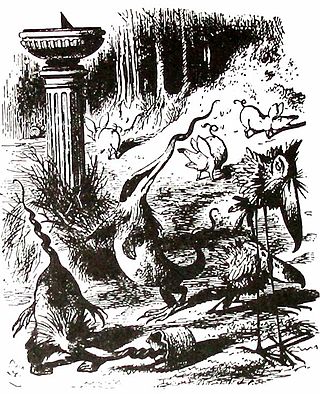
Literary nonsense is a broad categorization of literature that balances elements that make sense with some that do not, with the effect of subverting language conventions or logical reasoning. Even though the most well-known form of literary nonsense is nonsense verse, the genre is present in many forms of literature.

Tottles was a character from Lewis Carroll's novel Sylvie and Bruno Concluded (1893), the second volume following on from Sylvie and Bruno (1889). It includes a stanza on What Tottles Meant in Chapter 13.
"The Mouse's Tale" is a shaped poem by Lewis Carroll which appears in his 1865 novel Alice's Adventures in Wonderland. Though no formal title for the poem is given in the text, the chapter title refers to "A Long Tale" and the Mouse introduces it by saying, "Mine is a long and sad tale!" As well as the contribution of typography to illustrate the intended pun in this title, artists later made the intention clear as well. Translators of the story also encountered difficulty in conveying the meaning there, part of which was not recognised until well over a century later.

The Knave of Hearts is a character from the 1865 book Alice's Adventures in Wonderland by Lewis Carroll.
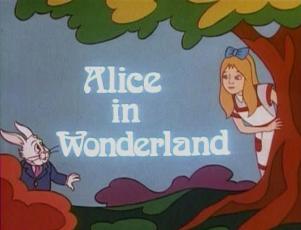
Alice in Wonderland is an Australian 51-minute direct-to-video animated film from Burbank Films Australia originally released in 1988.
"All in the golden afternoon" is the preface poem in Lewis Carroll's 1865 book Alice's Adventures in Wonderland. The introductory poem recalls the afternoon that he improvised the story about Alice in Wonderland while on a boat trip from Oxford to Godstow, for the benefit of the three Liddell sisters: Lorina Charlotte, Alice Pleasance, and Edith Mary. Alice gave her name to Carroll's main character.
"You Are Old, Father William" is a poem by Lewis Carroll that appears in his 1865 book Alice's Adventures in Wonderland. It is recited by Alice in Chapter 5, "Advice from a Caterpillar". Alice informs the Caterpillar that she has previously tried to repeat "How Doth the Little Busy Bee" and has had it all come wrong as "How Doth the Little Crocodile". The Caterpillar asks her to repeat "You Are Old, Father William", and she recites it.

George Edward Farrow born in Ipswich in England, was a noted British children's book author of whose life little is known.
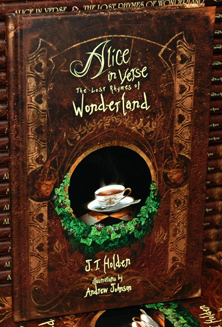
Alice in Verse: The Lost Rhymes of Wonderland (2010) is a reimagining of Lewis Carroll's 1865 novel Alice's Adventures in Wonderland written by British-American author J.T. Holden. It tells the story of Alice's Adventures in Wonderland in 19 rhyming poems, each written in the same style as Lewis Carroll's original verse. The book includes 36 illustrations by American artist Andrew Johnson.

Charles Lutwidge Dodgson, better known by his pen name Lewis Carroll, was an English author, poet, mathematician and photographer. His most notable works are Alice's Adventures in Wonderland (1865) and its sequel Through the Looking-Glass (1871). He was noted for his facility with word play, logic, and fantasy. His poems Jabberwocky (1871) and The Hunting of the Snark (1876) are classified in the genre of literary nonsense.

















